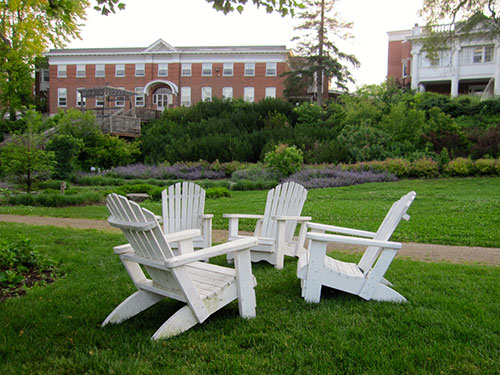
For landscape architecture professor Nathan Perkins, trees are more than giant plants; they’re more like friends and family. In fact, he named the trees in his own garden after his two sons and father. Olga is named after one of his grad students. “She thinks it’s really weird,” he says.
Perkins wants others to share his appreciation for nature — not necessarily by naming their trees, but by spending time outdoors, which he says has many benefits for mental and physical health. He says research has shown that surgical patients staying in hospital rooms with windows that faced a natural view required less pain medication and were released earlier on average than those whose windows faced a brick wall.
When his children were attending daycare in the mid-1990s on the grounds of Homewood Health Centre, a mental health and addictions facility in Guelph, its administrators approached Perkins to develop a research-based landscape master plan that would benefit both staff and patients.
“It engaged me in an area of work as a designer and a researcher that I probably would not have gotten into otherwise,” says Perkins, School of Environmental Design and Rural Development. “We all had the same aim to make life better for people in the programs.”
He consulted with patients, many of whom had serious addictions and mental health concerns, to find out how they used and what they wanted to see in Homewood’s outdoor space, which now includes sitting areas and walking trails. Since then, he has designed gardens for hospitals and schools in other North American cities, Italy and Australia. He is currently working on a children’s hospital in the Middle East.
Perkins also teaches a course on the environment’s role in health and well-being in Milan, Italy, where he teaches post-graduate architects, engineers and doctors how to design outdoor spaces for health-care facilities. “Hospitals in Europe and Australia are approaching universities and saying, ‘We really need your help. Make some suggestions, and we’ll implement them,’” he says.
Perkins also worked with Parkwood Hospital in London, Ont., to design a garden for male war veterans in its Alzheimer’s wing. Working with a graduate student, he spent six months analyzing the garden and how it was being used by patients and staff. The researchers discovered that many of the patients slept during the day and woke in the late afternoon or evening because of their condition. Patients were often asleep when the garden was open and awake when it was closed.
“Participatory design is absolutely essential,” says Perkins, who designs spaces in consultation with those who will use it to ensure that it meets their needs.
One of his recommendations was to install a flagpole in the garden so the veterans in the hospital could take turns raising and lowering the flag each day. He also advised keeping the garden open later in the day and shifting the hospital’s horticultural programs to begin when most of the patients were awake.
“The idea is that nurturing plants really lends itself well to therapeutic programs,” says Perkins. “There’s something deeply satisfying about growing things or at least helping things grow.”